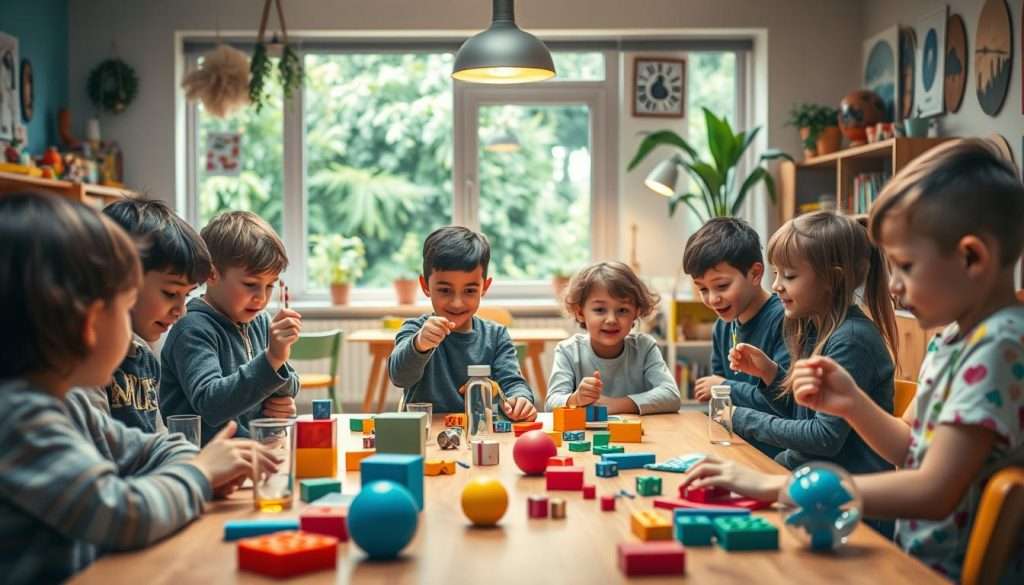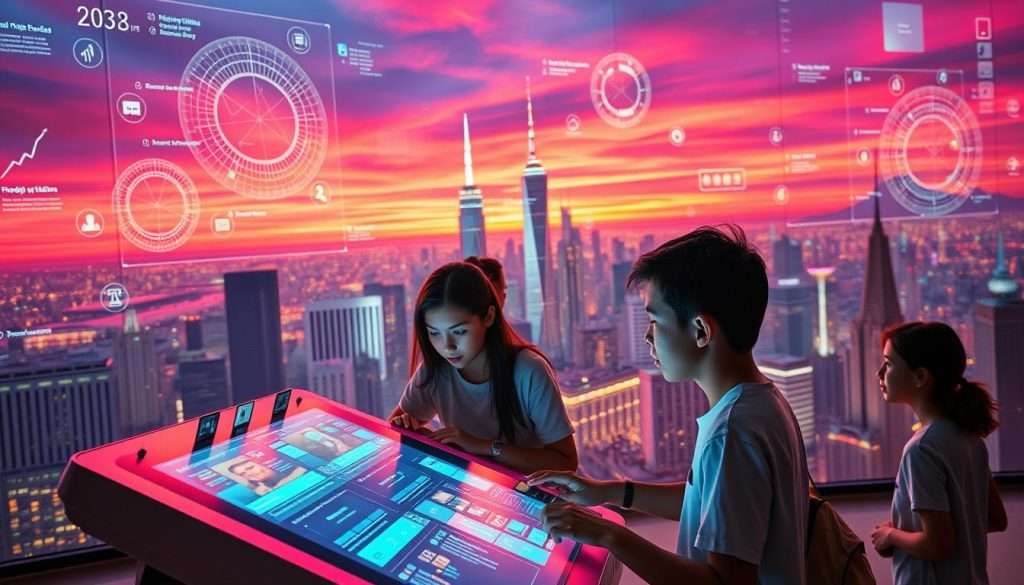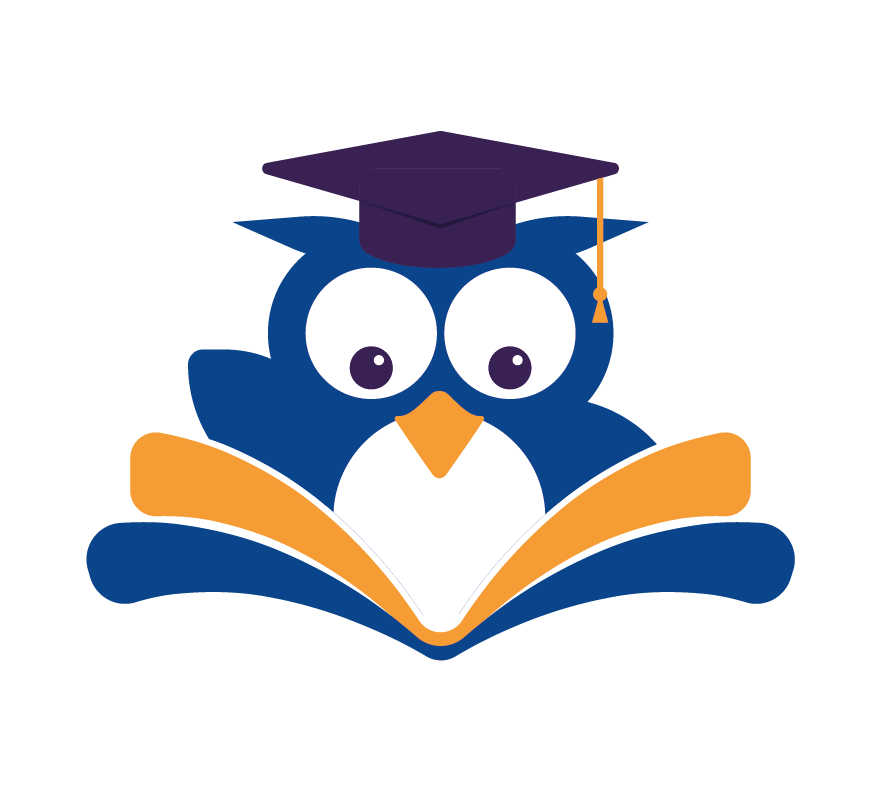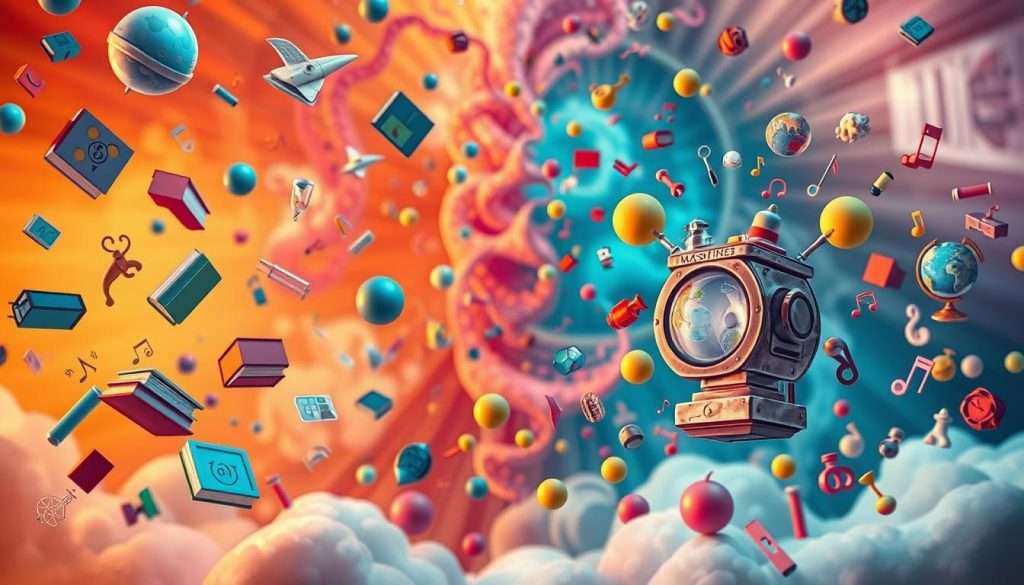We all know that learning is a lifelong journey. But did you know it can also be a fun adventure? From how our brains can change to the best ways to learn, there’s a lot to discover.
As we explore learning, we’ll share some fun facts. These will motivate you to learn more and enjoy your educational journey. Whether you’re a student or always learning, we’re here to explore with you!
Key Takeaways
- Discover the brain’s ability to rewire itself for improved learning.
- Learn the most effective techniques for retaining information.
- Explore the science behind learning and memory.
- Uncover the benefits of lifelong learning for personal and professional growth.
- Find out how to make learning a fun and enjoyable experience.
The Fascinating Science of How Our Brains Learn
Our brains are wired to learn. But have you ever wondered how that happens? Learning is complex, involving many brain parts and a network of neurons.
Neuroplasticity: Your Brain’s Superpower
One of the most surprising learning insights is neuroplasticity. This is the brain’s ability to change and adapt with age. It lets us learn new skills and take in new info, even as adults.
What Happens in Your Brain During Learning
Learning doesn’t just use one brain part; it’s a team effort. Let’s explore the details.
The Role of Neurons and Synapses
Neurons are the brain’s basic units, and synapses connect them. When we learn something new, new synapses form, and old ones get stronger. This is why “Neurons that fire together, wire together.”
“Your brain isn’t fully formed until age 25. Brain development starts from the back and moves to the front.”
Brain Regions Involved in Different Types of Learning
Each learning type – like motor skills, language, or problem-solving – uses different brain areas. Knowing this helps us make learning strategies more effective. It uncovers some fascinating educational curiosities.
Understanding how our brains learn opens up our full potential. It makes learning more efficient and fun.
Fun Facts About Learning That Will Blow Your Mind
Learning is full of surprises. We’re about to explore some quirky facts that will amaze you. Our brains can do incredible things. Understanding how we learn can make us better at it.
Learning While You Sleep Is Scientifically Proven
Did you know your brain keeps learning while you sleep? Studies show sleep is key for memory and learning. It helps your brain process and strengthen memories, making them easier to remember later.
We Learn Better When Teaching Others
Teaching others is a great way to learn more. It helps you understand and share complex ideas clearly. When you teach, you organize your thoughts and explain things in simple terms.
The Protégé Effect Explained
The protégé effect shows we learn better when teaching or preparing to teach. Teaching requires a deep understanding of the material. This deep understanding boosts our own learning.
| Learning Method | Effectiveness |
|---|---|
| Passive Reading | 20% |
| Teaching Others | 90% |
Teaching others is a very effective way to learn. So, when studying or learning a new skill, try teaching it to someone. You’ll be amazed at how much you remember!
The Surprising Truth About Memory and Knowledge Retention
Learning and remembering information is full of surprises. One key fact is that we forget a lot of what we learn quickly.
Why We Forget Almost 70% of What We Learn Within 24 Hours
Studies show our brains forget a lot of new info soon after we learn it. This is called the “forgetting curve.” Knowing this helps us find better ways to keep what we learn.
The Spacing Effect: Why Cramming Doesn’t Work
Cramming is a common study method, but it’s not the best. The spacing effect shows that reviewing material at longer intervals helps keep it in our minds better.
How to Use Spaced Repetition Effectively
To use spaced repetition, follow these steps:
- Review new info soon after learning it.
- Slowly increase the time between reviews.
- Use flashcards or apps for spaced repetition.
Adding spaced repetition to your study routine helps fight the forgetting curve. It’s a useful trick among many educational oddities.
Learning Across the Lifespan: From Infants to Seniors
Our brains are always ready to learn, from birth to old age. This amazing ability to take in and understand information never stops. It just changes how and what we learn as we grow.
Children’s Remarkable Language Acquisition Abilities
Infants and young kids can learn languages fast. They have more bones than adults, and their brains are super flexible. This lets them learn languages quickly, even without formal lessons.
Adult Learning Advantages That Kids Don’t Have
As we get older, our learning skills get better. We use our life experiences and smarter thinking to learn. This makes learning easier and more effective for us.
How the Aging Brain Continues to Learn
Even when we’re older, our brains can still learn new things. Some thinking skills might slow down, but we can still pick up new skills. This is thanks to our brain’s ability to change and adapt.
These unique learning discoveries show how amazing our brains are at learning at any age. Learning all our lives brings many benefits. It helps us grow and learn more, no matter how old we are. By learning about how we learn at different times, we find fun facts about learning that motivate us to keep growing.
The Powerful Connection Between Emotions and Learning
Our emotional experiences can either hinder or enhance our learning capabilities. Emotions play a significant role in how we absorb and retain new information. They are crucial to the learning process.
How Stress Creates a Learning Roadblock
When we’re under stress, our body’s “fight or flight” response is triggered. This releases hormones like cortisol. While these hormones help us react to immediate threats, chronically elevated levels can impair our ability to learn.
They reduce the growth of new neurons and disrupt connections between them.
The Surprising Benefits of Confusion in Learning
Confusion is often seen as negative, but it can spark deeper learning. When we’re confused, we’re prompted to re-evaluate our understanding. This leads us to seek out new information, fostering a more profound grasp of the subject matter.
Productive Struggle and Growth Mindset
Embracing challenges and persisting through difficulties is key to developing a growth mindset. By viewing obstacles as opportunities for growth, we can cultivate resilience. This enhances our learning capabilities.
| Emotional State | Impact on Learning |
|---|---|
| Stress | Can create a learning roadblock by impairing neural connections |
| Confusion | Can lead to deeper understanding through re-evaluation and seeking new information |
| Growth Mindset | Fosters resilience and enhances learning capabilities |
Unconventional Learning Methods That Science Supports
Science has found some surprising ways to boost your learning. These methods might seem odd at first. But, they’re backed by research and can really help you learn better.
The Feynman Technique for Mastering Any Subject
The Feynman Technique is a strong way to learn and remember tough stuff. It means teaching what you’ve learned to someone else in simple words. This way, you find out what you don’t know and really get the material.
Interleaving: Mixing Up Your Learning for Better Results
Interleaving is about switching between different kinds of material or problems. It helps you understand things better by mixing them up. This way, you can tell the difference between different ideas and use them right.

Retrieval Practice: The Testing Effect
Retrieval practice is about recalling information from memory without looking at notes. It makes you better at remembering and recalling information. Try quizzing yourself or using flashcards to practice this.
Adding these quirky learning revelations to your study routine can make learning fun and effective. Try them out and see the difference for yourself!
Physical Movement and Cognitive Performance
Moving your body can actually help you learn and remember more effectively. Research has shown that physical movement is closely linked to cognitive performance. It enhances our ability to absorb and retain information.
Exercise Before Learning Boosts Memory Formation
Engaging in physical exercise before a learning session can significantly improve memory formation. Exercise stimulates the growth of new neurons and improves the connections between them. This makes it easier to absorb new information.
Why Standing Desks Might Make You Smarter
Standing desks are more than just a trend; they can actually contribute to better cognitive function. By standing, you’re not only burning more calories but also improving your blood flow. This can enhance your brain’s performance.
The Optimal Movement Breaks for Learning Sessions
Incorporating regular movement breaks into your learning routine can maximize its effectiveness. Here’s a simple guide to optimal movement breaks:
| Break Duration | Activity | Benefit |
|---|---|---|
| 5 minutes | Stretching | Improves flexibility and blood flow |
| 10 minutes | Brisk walking | Boosts energy and focus |
| 15 minutes | Jumping jacks or dancing | Enhances cardiovascular health and mood |
By integrating these movement breaks into your study routine, you can potentially boost your learning outcomes.
The Multilingual Advantage: How Languages Transform Your Brain
Being multilingual offers more than just speaking different languages. It boosts problem-solving and cultural understanding. Let’s dive into how speaking more than one language changes our brains.
Bilingual Brains Show Enhanced Executive Function
Studies show bilingual people have better executive function. This includes planning, decision-making, and solving problems. Switching between languages strengthens the brain’s control systems.
Bilinguals also do well in tasks that need attention and quick changes. They adapt quickly to new info and situations.
Why Learning a New Language Gets Harder With Age
It’s possible to learn a new language at any age. Yet, younger learners usually find it easier to become fluent. As we get older, our brains change, making learning harder.
The Critical Period Hypothesis
The critical period hypothesis says there’s a best time to learn languages, usually in childhood and early teens. After that, learning languages becomes harder and less natural.
Knowing these challenges helps us find better ways to learn languages, no matter our age.
Digital Learning in the Modern Age
We’re seeing a big change in how we learn, thanks to digital tools and new methods. This shift brings interesting educational tidbits that change how we study.
Screen Time Effects on Attention and Learning
Digital learning has many benefits, but too much screen time can hurt our focus. Studies show that too much screen time can make it harder to concentrate and increase distractions. But, used right, digital tools can really help us learn better.
Gamification: When Learning Becomes Play
Gamification is an educational oddity that’s really catching on. It makes learning fun by adding game elements. This not only makes learning more enjoyable but also helps us remember what we learn.
Effective Educational Technology Strategies
To get the most out of digital learning, teachers can use a few key strategies:
- Personalized learning paths tailored to individual needs
- Interactive content that encourages active participation
- Real-time feedback mechanisms to track progress
Let’s look at how different tech strategies work:
| Strategy | Engagement Level | Knowledge Retention |
|---|---|---|
| Personalized Learning | High | Excellent |
| Gamification | Very High | Good |
| Interactive Content | High | Very Good |

By using these digital learning strategies, we can make learning more fun and effective. As we keep exploring tech’s role in education, we find more interesting educational tidbits to help us learn.
Music, Art, and Creative Learning Connections
Let’s explore how music, art, and learning come together in exciting ways. Doing creative activities is more than just fun. It can really boost your learning.
The Mozart Effect: Myth vs. Reality
The Mozart Effect claims that Mozart’s music can make your brain work better. While it’s not as big of an effect as some thought, studies show music can help your brain learn and process things.
How Learning Music Affects Mathematical Ability
Learning music can help with math skills. The discipline and pattern recognition in music can improve your math problem-solving abilities.
Visual Arts and Spatial Reasoning Development
Visual arts can also boost your spatial reasoning. This is key for math and engineering. It helps you better visualize and handle objects in space, strengthening your skills in these subjects.
Adding music and art to your learning can open up new ways to understand and remember things. It makes learning more fun and effective.
Social Dimensions of Learning: We Learn Better Together
Learning alone has its value, but learning together brings unexpected benefits. When we work together, we uncover surprising learning insights that solo study might miss.
The Power of Collaborative Learning
Collaborative learning is more than just group work. It’s about combining everyone’s knowledge and views to deepen our understanding. Studies show that team learning boosts grades and social skills.
Learning together makes us more active learners. Explaining ideas to others helps us grasp and remember them better. It also sharpens our critical thinking and problem-solving abilities.
Cultural Differences in Learning Approaches
Culture greatly influences how we learn. Each culture has its own educational views that shape our learning and interaction with school materials.
Eastern vs. Western Educational Philosophies
Eastern cultures often value respect for authority and memorization. Western cultures, on the other hand, focus on critical thinking and questioning. Knowing these differences can add depth to our learning journey.
| Aspect | Eastern Approach | Western Approach |
|---|---|---|
| Learning Style | Rote memorization, respect for authority | Critical thinking, questioning |
| Classroom Environment | Formal, teacher-centered | Informal, student-centered |
| Assessment Methods | Examinations, standardized tests | Continuous assessment, project-based |
By embracing these cultural differences, we can craft a more effective learning strategy. This approach combines the best of various educational philosophies.
Conclusion: Embracing the Joy of Lifelong Learning
Learning is a lifelong journey filled with unique discoveries and fascinating trivia. We’ve learned how our brains learn and how emotions play a role. This makes learning enjoyable and effective.
Learning isn’t just for school; it’s a lifelong process. Whether you’re a student or a lifelong learner, gaining new knowledge is rewarding. It enriches your life personally and professionally.
We encourage you to keep exploring and growing. Make learning a joyful part of your life by trying new things and teaching others. This way, you’ll not only learn more but also understand the world better.

